Comprehensive Report: Taxation Law Case of RIP Pty Limited
VerifiedAdded on 2022/04/02
|10
|3489
|30
Report
AI Summary
This report provides a detailed analysis of the taxation law case involving RIP Pty Limited. It begins with an introduction to the principles of taxation law, including the concept of assessable income and the importance of accrual basis accounting. The report then delves into the facts, issues, and conclusion of the Arthur Murray case, a key precedent in determining when income is derived. It examines how RIP Pty Limited derives its income from funeral services and related activities, considering the implications of advance payments and the potential application of the Arthur Murray principles. Part B covers the treatment of trading stock, adjustments to fully franked dividends, and the tax implications. The report provides guidance on the treatment of forfeited payments, trading stock valuation, and the implications of fully franked dividends, offering a comprehensive overview of the taxation issues relevant to RIP Pty Limited's business operations.
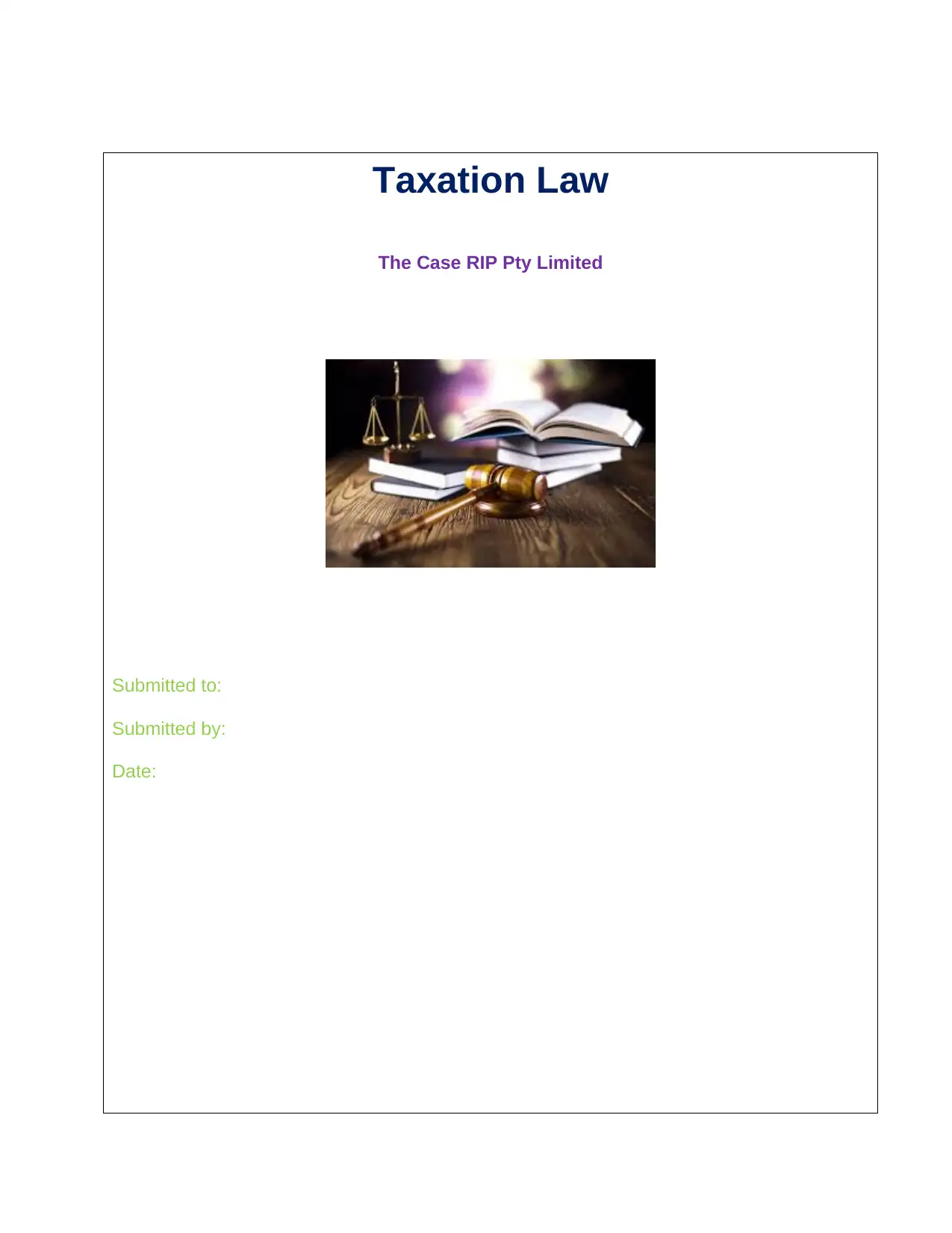
Taxation Law
The Case RIP Pty Limited
Submitted to:
Submitted by:
Date:
The Case RIP Pty Limited
Submitted to:
Submitted by:
Date:
Paraphrase This Document
Need a fresh take? Get an instant paraphrase of this document with our AI Paraphraser
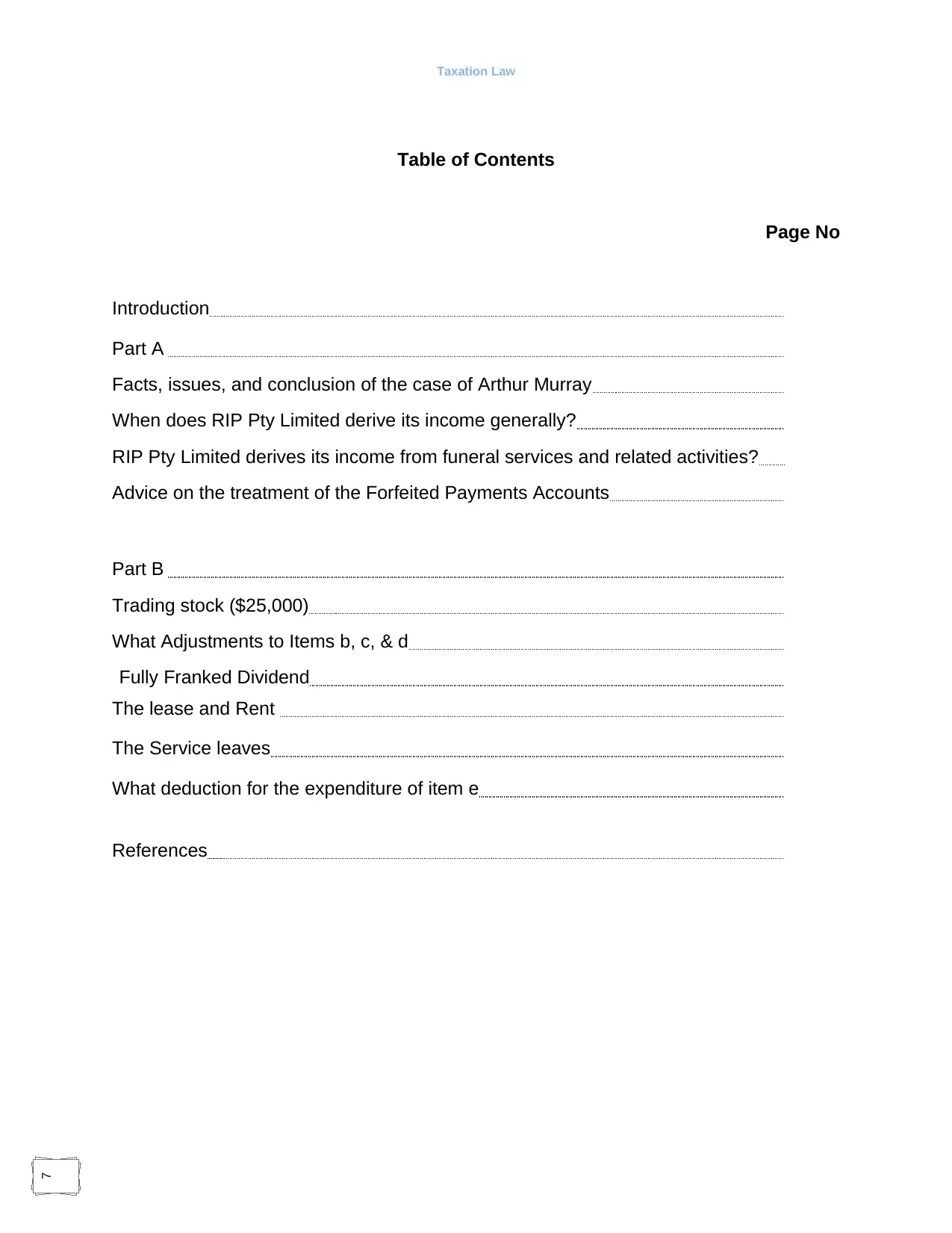
7
Taxation Law
Table of Contents
Page No
Introduction
Part A
Facts, issues, and conclusion of the case of Arthur Murray
When does RIP Pty Limited derive its income generally?
RIP Pty Limited derives its income from funeral services and related activities?
Advice on the treatment of the Forfeited Payments Accounts
Part B
Trading stock ($25,000)
What Adjustments to Items b, c, & d
Fully Franked Dividend
The lease and Rent
The Service leaves
What deduction for the expenditure of item e
References
Taxation Law
Table of Contents
Page No
Introduction
Part A
Facts, issues, and conclusion of the case of Arthur Murray
When does RIP Pty Limited derive its income generally?
RIP Pty Limited derives its income from funeral services and related activities?
Advice on the treatment of the Forfeited Payments Accounts
Part B
Trading stock ($25,000)
What Adjustments to Items b, c, & d
Fully Franked Dividend
The lease and Rent
The Service leaves
What deduction for the expenditure of item e
References

7
Taxation Law
Introduction:
According to the requirements of the laws, a taxpayer is required to compute its relevant
assessable income for income tax purposes for the applicable financial period. Business
organizations, record all income relevant to specific business activities are recorded in
the specific accounts on accruals basis. The business activities as sale of goods, and
revenue from the services are main activities those need accrual basis accounting
treatment. The principle of accrual has significant impact on the business activities
having earned and unearned income portion. The business involved the professional
practice derives its assessable income on the annual basis, income is derived when the
person invoice the amount or earned it actually. The taxpayer needs to review the
income in accrual basis to transfer the earned portion of the unearned income to make
them assessable income for the tax calculations (Year-end tax planning toolkit, 2016).
Unearned income, normally, treated as deferred income; many companies in the past
failed to properly report the derived income for tax purposes and eventually, faced the
lawsuit. There is various Court judgments stated that business organizations failed to
apply requirements of law to fairy report their taxable income. It has significant
importance to recognize whether an amount earned and unearned income has reported
as required. Till 30 June 2016, small business enterprises, having less than $2 million
turnovers, taxed at rate of 28.5% but after 1 July 2016, they are being taxed at 27.5% if
having a turnover less than $10 million as Australian Government announced in the
budget (Tax Summary, 2017).
Taxation Law
Introduction:
According to the requirements of the laws, a taxpayer is required to compute its relevant
assessable income for income tax purposes for the applicable financial period. Business
organizations, record all income relevant to specific business activities are recorded in
the specific accounts on accruals basis. The business activities as sale of goods, and
revenue from the services are main activities those need accrual basis accounting
treatment. The principle of accrual has significant impact on the business activities
having earned and unearned income portion. The business involved the professional
practice derives its assessable income on the annual basis, income is derived when the
person invoice the amount or earned it actually. The taxpayer needs to review the
income in accrual basis to transfer the earned portion of the unearned income to make
them assessable income for the tax calculations (Year-end tax planning toolkit, 2016).
Unearned income, normally, treated as deferred income; many companies in the past
failed to properly report the derived income for tax purposes and eventually, faced the
lawsuit. There is various Court judgments stated that business organizations failed to
apply requirements of law to fairy report their taxable income. It has significant
importance to recognize whether an amount earned and unearned income has reported
as required. Till 30 June 2016, small business enterprises, having less than $2 million
turnovers, taxed at rate of 28.5% but after 1 July 2016, they are being taxed at 27.5% if
having a turnover less than $10 million as Australian Government announced in the
budget (Tax Summary, 2017).
⊘ This is a preview!⊘
Do you want full access?
Subscribe today to unlock all pages.

Trusted by 1+ million students worldwide

7
Taxation Law
Part A
a. Facts, issues, and conclusion of the case of Arthur Murray:
Arthur Murray (NSW) Pty Ltd was a dancing school, and Arthur Murray was the
taxpayer who was conducting the business of providing the dancing lessons. Arthur
Murray had obtained advance payments of the tuition fees in return for the dancing
lessons from its customers. In the case the issues were related to the assessable
income for tax purposes from the advance tuition fees. Arthur Murray in his income tax
return reported the advance tuition fees as liability in the term of unearned income.
(BARWICK, J C et al., 1965). The interpretation of the case put significant impact on the
private business organization as this case highlighted the important points like the
treatment of advance future tuition fees, reporting of assessable income, and the
accounting procedures for the tax treatment of assessable income as mentioned in the
Income Tax and Social Services Contribution Assessment Act 1936 (High Court of
Australia, 1965).
When Arthur Murray deposited its income tax returns, he had reported the advance
tuition fees for dancing classes as unearned income rather than assessable income on
its income tax return, the intentions behind this reporting that the advance fees were
liabilities as they would be reported as earned income after providing the dancing
lessons. The tax commissioner evaluated the Arthur Murray on the basis that advance
fees were assessable income should had been reported as assessable income by the
Arthur Murray and he brought the case in the Court (Prepaid Income – Arthur Murray
Case, 2018).
In its judgment, the Court found that the Arthur Murray had not derived the advance
received amounts of fees for dancing lessons until he actually delivered the dancing
lessons to customers. The Court considered this practice appropriate and stated that it
had shown the good business sense when the business keeps the advance fees as a
contingency to repay in full or part of the taxpayer fees received but not yet earned’ if
the taxpayer failed to deliver the agreed services (High Court of Australia, 1965).
i. When does RIP Pty Limited derive its income generally?
According to the ordinary concepts and subsection 25 (1) of the “Income Tax
Assessment Act 1936”, when the taxpayer enters into a contract to provide a service for
advance fees, a recoverable debt to the taxpayer of advance fee arises if he billed the
customer and the income will be assessable on the completion of the contract for
proving the service (Taxation Rulling, 1993). Keeping in view the provision of the law
and considering the nature of the business; generally, the RIP Pty Limited should derive
its income when it actually earns the income, or in other words, it should report its
income for tax purposes if it earns it in that financial year or when there is no contract or
agreement with client to repay or refund in the event of failure to render the contracted
services. The advance payments or tuition fees obtained in advance could not be
Taxation Law
Part A
a. Facts, issues, and conclusion of the case of Arthur Murray:
Arthur Murray (NSW) Pty Ltd was a dancing school, and Arthur Murray was the
taxpayer who was conducting the business of providing the dancing lessons. Arthur
Murray had obtained advance payments of the tuition fees in return for the dancing
lessons from its customers. In the case the issues were related to the assessable
income for tax purposes from the advance tuition fees. Arthur Murray in his income tax
return reported the advance tuition fees as liability in the term of unearned income.
(BARWICK, J C et al., 1965). The interpretation of the case put significant impact on the
private business organization as this case highlighted the important points like the
treatment of advance future tuition fees, reporting of assessable income, and the
accounting procedures for the tax treatment of assessable income as mentioned in the
Income Tax and Social Services Contribution Assessment Act 1936 (High Court of
Australia, 1965).
When Arthur Murray deposited its income tax returns, he had reported the advance
tuition fees for dancing classes as unearned income rather than assessable income on
its income tax return, the intentions behind this reporting that the advance fees were
liabilities as they would be reported as earned income after providing the dancing
lessons. The tax commissioner evaluated the Arthur Murray on the basis that advance
fees were assessable income should had been reported as assessable income by the
Arthur Murray and he brought the case in the Court (Prepaid Income – Arthur Murray
Case, 2018).
In its judgment, the Court found that the Arthur Murray had not derived the advance
received amounts of fees for dancing lessons until he actually delivered the dancing
lessons to customers. The Court considered this practice appropriate and stated that it
had shown the good business sense when the business keeps the advance fees as a
contingency to repay in full or part of the taxpayer fees received but not yet earned’ if
the taxpayer failed to deliver the agreed services (High Court of Australia, 1965).
i. When does RIP Pty Limited derive its income generally?
According to the ordinary concepts and subsection 25 (1) of the “Income Tax
Assessment Act 1936”, when the taxpayer enters into a contract to provide a service for
advance fees, a recoverable debt to the taxpayer of advance fee arises if he billed the
customer and the income will be assessable on the completion of the contract for
proving the service (Taxation Rulling, 1993). Keeping in view the provision of the law
and considering the nature of the business; generally, the RIP Pty Limited should derive
its income when it actually earns the income, or in other words, it should report its
income for tax purposes if it earns it in that financial year or when there is no contract or
agreement with client to repay or refund in the event of failure to render the contracted
services. The advance payments or tuition fees obtained in advance could not be
Paraphrase This Document
Need a fresh take? Get an instant paraphrase of this document with our AI Paraphraser
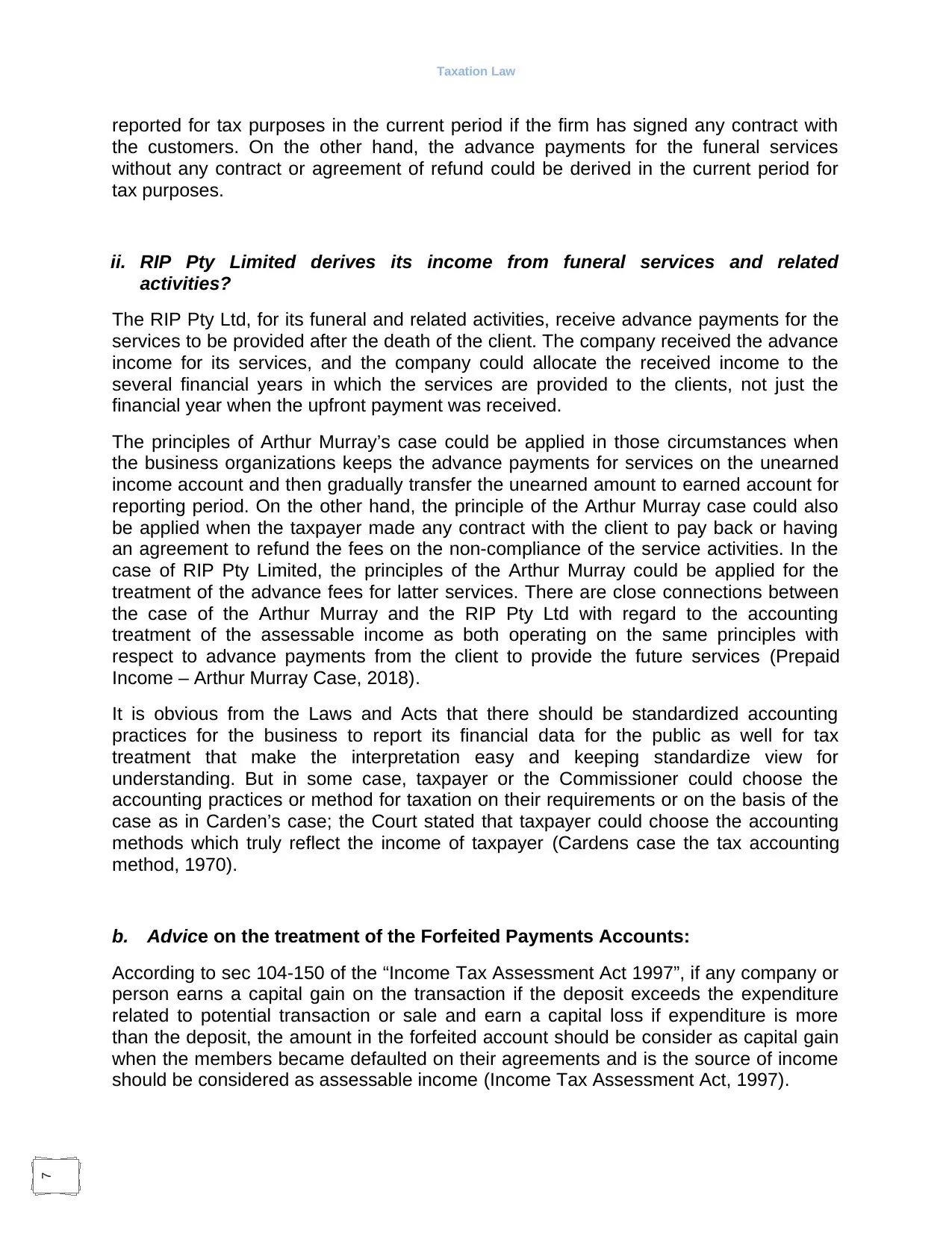
7
Taxation Law
reported for tax purposes in the current period if the firm has signed any contract with
the customers. On the other hand, the advance payments for the funeral services
without any contract or agreement of refund could be derived in the current period for
tax purposes.
ii. RIP Pty Limited derives its income from funeral services and related
activities?
The RIP Pty Ltd, for its funeral and related activities, receive advance payments for the
services to be provided after the death of the client. The company received the advance
income for its services, and the company could allocate the received income to the
several financial years in which the services are provided to the clients, not just the
financial year when the upfront payment was received.
The principles of Arthur Murray’s case could be applied in those circumstances when
the business organizations keeps the advance payments for services on the unearned
income account and then gradually transfer the unearned amount to earned account for
reporting period. On the other hand, the principle of the Arthur Murray case could also
be applied when the taxpayer made any contract with the client to pay back or having
an agreement to refund the fees on the non-compliance of the service activities. In the
case of RIP Pty Limited, the principles of the Arthur Murray could be applied for the
treatment of the advance fees for latter services. There are close connections between
the case of the Arthur Murray and the RIP Pty Ltd with regard to the accounting
treatment of the assessable income as both operating on the same principles with
respect to advance payments from the client to provide the future services (Prepaid
Income – Arthur Murray Case, 2018).
It is obvious from the Laws and Acts that there should be standardized accounting
practices for the business to report its financial data for the public as well for tax
treatment that make the interpretation easy and keeping standardize view for
understanding. But in some case, taxpayer or the Commissioner could choose the
accounting practices or method for taxation on their requirements or on the basis of the
case as in Carden’s case; the Court stated that taxpayer could choose the accounting
methods which truly reflect the income of taxpayer (Cardens case the tax accounting
method, 1970).
b. Advice on the treatment of the Forfeited Payments Accounts:
According to sec 104-150 of the “Income Tax Assessment Act 1997”, if any company or
person earns a capital gain on the transaction if the deposit exceeds the expenditure
related to potential transaction or sale and earn a capital loss if expenditure is more
than the deposit, the amount in the forfeited account should be consider as capital gain
when the members became defaulted on their agreements and is the source of income
should be considered as assessable income (Income Tax Assessment Act, 1997).
Taxation Law
reported for tax purposes in the current period if the firm has signed any contract with
the customers. On the other hand, the advance payments for the funeral services
without any contract or agreement of refund could be derived in the current period for
tax purposes.
ii. RIP Pty Limited derives its income from funeral services and related
activities?
The RIP Pty Ltd, for its funeral and related activities, receive advance payments for the
services to be provided after the death of the client. The company received the advance
income for its services, and the company could allocate the received income to the
several financial years in which the services are provided to the clients, not just the
financial year when the upfront payment was received.
The principles of Arthur Murray’s case could be applied in those circumstances when
the business organizations keeps the advance payments for services on the unearned
income account and then gradually transfer the unearned amount to earned account for
reporting period. On the other hand, the principle of the Arthur Murray case could also
be applied when the taxpayer made any contract with the client to pay back or having
an agreement to refund the fees on the non-compliance of the service activities. In the
case of RIP Pty Limited, the principles of the Arthur Murray could be applied for the
treatment of the advance fees for latter services. There are close connections between
the case of the Arthur Murray and the RIP Pty Ltd with regard to the accounting
treatment of the assessable income as both operating on the same principles with
respect to advance payments from the client to provide the future services (Prepaid
Income – Arthur Murray Case, 2018).
It is obvious from the Laws and Acts that there should be standardized accounting
practices for the business to report its financial data for the public as well for tax
treatment that make the interpretation easy and keeping standardize view for
understanding. But in some case, taxpayer or the Commissioner could choose the
accounting practices or method for taxation on their requirements or on the basis of the
case as in Carden’s case; the Court stated that taxpayer could choose the accounting
methods which truly reflect the income of taxpayer (Cardens case the tax accounting
method, 1970).
b. Advice on the treatment of the Forfeited Payments Accounts:
According to sec 104-150 of the “Income Tax Assessment Act 1997”, if any company or
person earns a capital gain on the transaction if the deposit exceeds the expenditure
related to potential transaction or sale and earn a capital loss if expenditure is more
than the deposit, the amount in the forfeited account should be consider as capital gain
when the members became defaulted on their agreements and is the source of income
should be considered as assessable income (Income Tax Assessment Act, 1997).
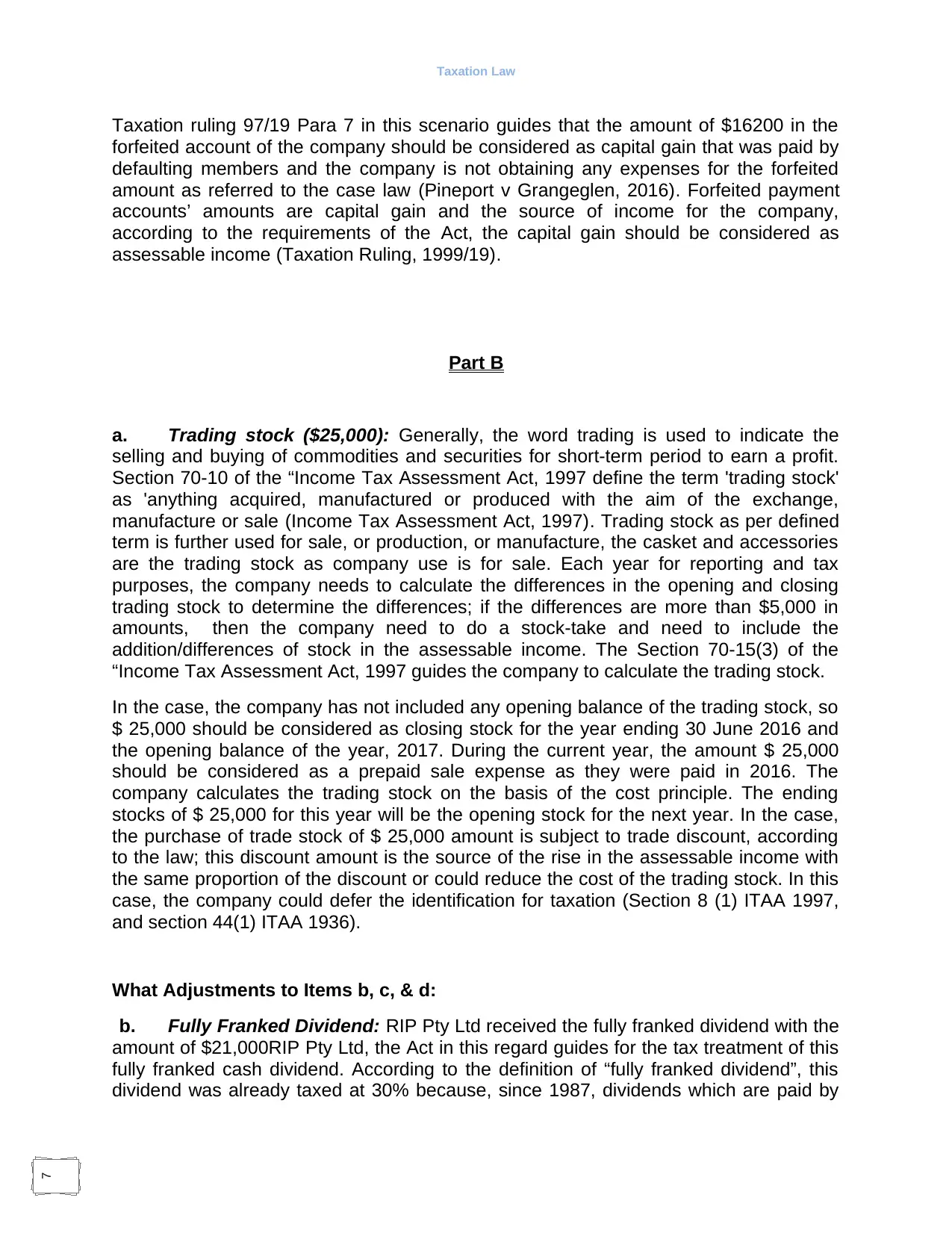
7
Taxation Law
Taxation ruling 97/19 Para 7 in this scenario guides that the amount of $16200 in the
forfeited account of the company should be considered as capital gain that was paid by
defaulting members and the company is not obtaining any expenses for the forfeited
amount as referred to the case law (Pineport v Grangeglen, 2016). Forfeited payment
accounts’ amounts are capital gain and the source of income for the company,
according to the requirements of the Act, the capital gain should be considered as
assessable income (Taxation Ruling, 1999/19).
Part B
a. Trading stock ($25,000): Generally, the word trading is used to indicate the
selling and buying of commodities and securities for short-term period to earn a profit.
Section 70-10 of the “Income Tax Assessment Act, 1997 define the term 'trading stock'
as 'anything acquired, manufactured or produced with the aim of the exchange,
manufacture or sale (Income Tax Assessment Act, 1997). Trading stock as per defined
term is further used for sale, or production, or manufacture, the casket and accessories
are the trading stock as company use is for sale. Each year for reporting and tax
purposes, the company needs to calculate the differences in the opening and closing
trading stock to determine the differences; if the differences are more than $5,000 in
amounts, then the company need to do a stock-take and need to include the
addition/differences of stock in the assessable income. The Section 70-15(3) of the
“Income Tax Assessment Act, 1997 guides the company to calculate the trading stock.
In the case, the company has not included any opening balance of the trading stock, so
$ 25,000 should be considered as closing stock for the year ending 30 June 2016 and
the opening balance of the year, 2017. During the current year, the amount $ 25,000
should be considered as a prepaid sale expense as they were paid in 2016. The
company calculates the trading stock on the basis of the cost principle. The ending
stocks of $ 25,000 for this year will be the opening stock for the next year. In the case,
the purchase of trade stock of $ 25,000 amount is subject to trade discount, according
to the law; this discount amount is the source of the rise in the assessable income with
the same proportion of the discount or could reduce the cost of the trading stock. In this
case, the company could defer the identification for taxation (Section 8 (1) ITAA 1997,
and section 44(1) ITAA 1936).
What Adjustments to Items b, c, & d:
b. Fully Franked Dividend: RIP Pty Ltd received the fully franked dividend with the
amount of $21,000RIP Pty Ltd, the Act in this regard guides for the tax treatment of this
fully franked cash dividend. According to the definition of “fully franked dividend”, this
dividend was already taxed at 30% because, since 1987, dividends which are paid by
Taxation Law
Taxation ruling 97/19 Para 7 in this scenario guides that the amount of $16200 in the
forfeited account of the company should be considered as capital gain that was paid by
defaulting members and the company is not obtaining any expenses for the forfeited
amount as referred to the case law (Pineport v Grangeglen, 2016). Forfeited payment
accounts’ amounts are capital gain and the source of income for the company,
according to the requirements of the Act, the capital gain should be considered as
assessable income (Taxation Ruling, 1999/19).
Part B
a. Trading stock ($25,000): Generally, the word trading is used to indicate the
selling and buying of commodities and securities for short-term period to earn a profit.
Section 70-10 of the “Income Tax Assessment Act, 1997 define the term 'trading stock'
as 'anything acquired, manufactured or produced with the aim of the exchange,
manufacture or sale (Income Tax Assessment Act, 1997). Trading stock as per defined
term is further used for sale, or production, or manufacture, the casket and accessories
are the trading stock as company use is for sale. Each year for reporting and tax
purposes, the company needs to calculate the differences in the opening and closing
trading stock to determine the differences; if the differences are more than $5,000 in
amounts, then the company need to do a stock-take and need to include the
addition/differences of stock in the assessable income. The Section 70-15(3) of the
“Income Tax Assessment Act, 1997 guides the company to calculate the trading stock.
In the case, the company has not included any opening balance of the trading stock, so
$ 25,000 should be considered as closing stock for the year ending 30 June 2016 and
the opening balance of the year, 2017. During the current year, the amount $ 25,000
should be considered as a prepaid sale expense as they were paid in 2016. The
company calculates the trading stock on the basis of the cost principle. The ending
stocks of $ 25,000 for this year will be the opening stock for the next year. In the case,
the purchase of trade stock of $ 25,000 amount is subject to trade discount, according
to the law; this discount amount is the source of the rise in the assessable income with
the same proportion of the discount or could reduce the cost of the trading stock. In this
case, the company could defer the identification for taxation (Section 8 (1) ITAA 1997,
and section 44(1) ITAA 1936).
What Adjustments to Items b, c, & d:
b. Fully Franked Dividend: RIP Pty Ltd received the fully franked dividend with the
amount of $21,000RIP Pty Ltd, the Act in this regard guides for the tax treatment of this
fully franked cash dividend. According to the definition of “fully franked dividend”, this
dividend was already taxed at 30% because, since 1987, dividends which are paid by
⊘ This is a preview!⊘
Do you want full access?
Subscribe today to unlock all pages.

Trusted by 1+ million students worldwide
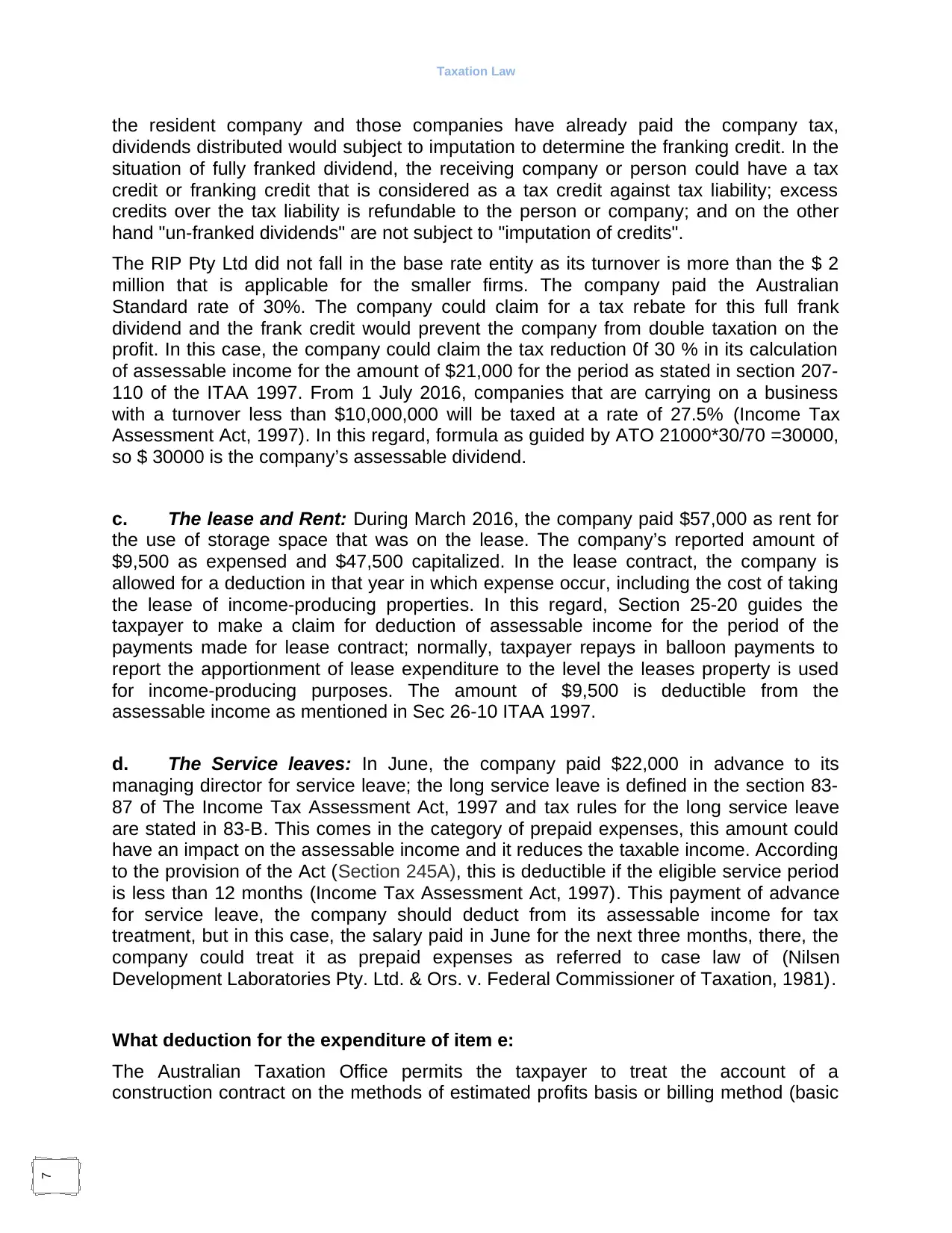
7
Taxation Law
the resident company and those companies have already paid the company tax,
dividends distributed would subject to imputation to determine the franking credit. In the
situation of fully franked dividend, the receiving company or person could have a tax
credit or franking credit that is considered as a tax credit against tax liability; excess
credits over the tax liability is refundable to the person or company; and on the other
hand "un-franked dividends" are not subject to "imputation of credits".
The RIP Pty Ltd did not fall in the base rate entity as its turnover is more than the $ 2
million that is applicable for the smaller firms. The company paid the Australian
Standard rate of 30%. The company could claim for a tax rebate for this full frank
dividend and the frank credit would prevent the company from double taxation on the
profit. In this case, the company could claim the tax reduction 0f 30 % in its calculation
of assessable income for the amount of $21,000 for the period as stated in section 207-
110 of the ITAA 1997. From 1 July 2016, companies that are carrying on a business
with a turnover less than $10,000,000 will be taxed at a rate of 27.5% (Income Tax
Assessment Act, 1997). In this regard, formula as guided by ATO 21000*30/70 =30000,
so $ 30000 is the company’s assessable dividend.
c. The lease and Rent: During March 2016, the company paid $57,000 as rent for
the use of storage space that was on the lease. The company’s reported amount of
$9,500 as expensed and $47,500 capitalized. In the lease contract, the company is
allowed for a deduction in that year in which expense occur, including the cost of taking
the lease of income-producing properties. In this regard, Section 25-20 guides the
taxpayer to make a claim for deduction of assessable income for the period of the
payments made for lease contract; normally, taxpayer repays in balloon payments to
report the apportionment of lease expenditure to the level the leases property is used
for income-producing purposes. The amount of $9,500 is deductible from the
assessable income as mentioned in Sec 26-10 ITAA 1997.
d. The Service leaves: In June, the company paid $22,000 in advance to its
managing director for service leave; the long service leave is defined in the section 83-
87 of The Income Tax Assessment Act, 1997 and tax rules for the long service leave
are stated in 83-B. This comes in the category of prepaid expenses, this amount could
have an impact on the assessable income and it reduces the taxable income. According
to the provision of the Act (Section 245A), this is deductible if the eligible service period
is less than 12 months (Income Tax Assessment Act, 1997). This payment of advance
for service leave, the company should deduct from its assessable income for tax
treatment, but in this case, the salary paid in June for the next three months, there, the
company could treat it as prepaid expenses as referred to case law of (Nilsen
Development Laboratories Pty. Ltd. & Ors. v. Federal Commissioner of Taxation, 1981).
What deduction for the expenditure of item e:
The Australian Taxation Office permits the taxpayer to treat the account of a
construction contract on the methods of estimated profits basis or billing method (basic
Taxation Law
the resident company and those companies have already paid the company tax,
dividends distributed would subject to imputation to determine the franking credit. In the
situation of fully franked dividend, the receiving company or person could have a tax
credit or franking credit that is considered as a tax credit against tax liability; excess
credits over the tax liability is refundable to the person or company; and on the other
hand "un-franked dividends" are not subject to "imputation of credits".
The RIP Pty Ltd did not fall in the base rate entity as its turnover is more than the $ 2
million that is applicable for the smaller firms. The company paid the Australian
Standard rate of 30%. The company could claim for a tax rebate for this full frank
dividend and the frank credit would prevent the company from double taxation on the
profit. In this case, the company could claim the tax reduction 0f 30 % in its calculation
of assessable income for the amount of $21,000 for the period as stated in section 207-
110 of the ITAA 1997. From 1 July 2016, companies that are carrying on a business
with a turnover less than $10,000,000 will be taxed at a rate of 27.5% (Income Tax
Assessment Act, 1997). In this regard, formula as guided by ATO 21000*30/70 =30000,
so $ 30000 is the company’s assessable dividend.
c. The lease and Rent: During March 2016, the company paid $57,000 as rent for
the use of storage space that was on the lease. The company’s reported amount of
$9,500 as expensed and $47,500 capitalized. In the lease contract, the company is
allowed for a deduction in that year in which expense occur, including the cost of taking
the lease of income-producing properties. In this regard, Section 25-20 guides the
taxpayer to make a claim for deduction of assessable income for the period of the
payments made for lease contract; normally, taxpayer repays in balloon payments to
report the apportionment of lease expenditure to the level the leases property is used
for income-producing purposes. The amount of $9,500 is deductible from the
assessable income as mentioned in Sec 26-10 ITAA 1997.
d. The Service leaves: In June, the company paid $22,000 in advance to its
managing director for service leave; the long service leave is defined in the section 83-
87 of The Income Tax Assessment Act, 1997 and tax rules for the long service leave
are stated in 83-B. This comes in the category of prepaid expenses, this amount could
have an impact on the assessable income and it reduces the taxable income. According
to the provision of the Act (Section 245A), this is deductible if the eligible service period
is less than 12 months (Income Tax Assessment Act, 1997). This payment of advance
for service leave, the company should deduct from its assessable income for tax
treatment, but in this case, the salary paid in June for the next three months, there, the
company could treat it as prepaid expenses as referred to case law of (Nilsen
Development Laboratories Pty. Ltd. & Ors. v. Federal Commissioner of Taxation, 1981).
What deduction for the expenditure of item e:
The Australian Taxation Office permits the taxpayer to treat the account of a
construction contract on the methods of estimated profits basis or billing method (basic
Paraphrase This Document
Need a fresh take? Get an instant paraphrase of this document with our AI Paraphraser
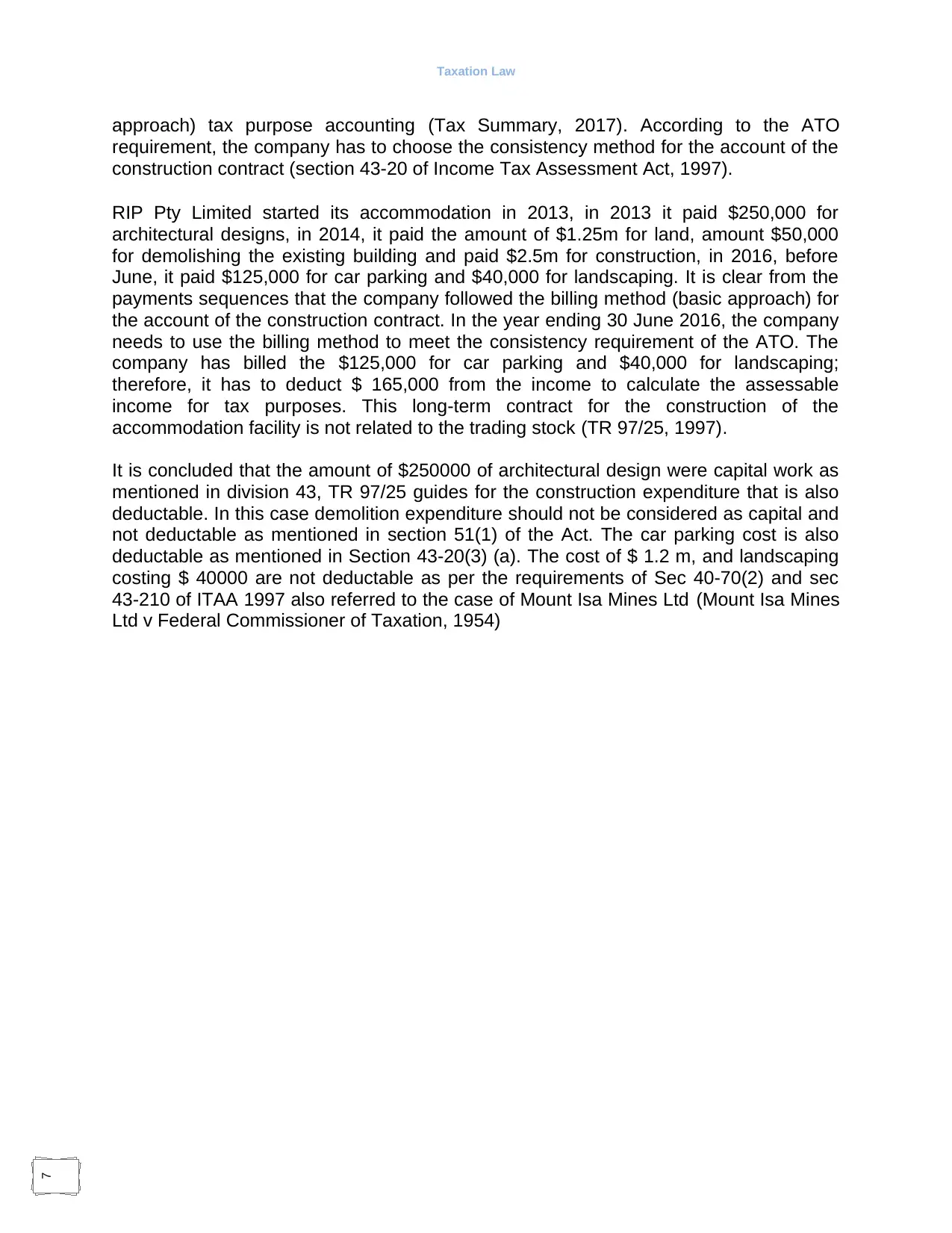
7
Taxation Law
approach) tax purpose accounting (Tax Summary, 2017). According to the ATO
requirement, the company has to choose the consistency method for the account of the
construction contract (section 43-20 of Income Tax Assessment Act, 1997).
RIP Pty Limited started its accommodation in 2013, in 2013 it paid $250,000 for
architectural designs, in 2014, it paid the amount of $1.25m for land, amount $50,000
for demolishing the existing building and paid $2.5m for construction, in 2016, before
June, it paid $125,000 for car parking and $40,000 for landscaping. It is clear from the
payments sequences that the company followed the billing method (basic approach) for
the account of the construction contract. In the year ending 30 June 2016, the company
needs to use the billing method to meet the consistency requirement of the ATO. The
company has billed the $125,000 for car parking and $40,000 for landscaping;
therefore, it has to deduct $ 165,000 from the income to calculate the assessable
income for tax purposes. This long-term contract for the construction of the
accommodation facility is not related to the trading stock (TR 97/25, 1997).
It is concluded that the amount of $250000 of architectural design were capital work as
mentioned in division 43, TR 97/25 guides for the construction expenditure that is also
deductable. In this case demolition expenditure should not be considered as capital and
not deductable as mentioned in section 51(1) of the Act. The car parking cost is also
deductable as mentioned in Section 43-20(3) (a). The cost of $ 1.2 m, and landscaping
costing $ 40000 are not deductable as per the requirements of Sec 40-70(2) and sec
43-210 of ITAA 1997 also referred to the case of Mount Isa Mines Ltd (Mount Isa Mines
Ltd v Federal Commissioner of Taxation, 1954)
Taxation Law
approach) tax purpose accounting (Tax Summary, 2017). According to the ATO
requirement, the company has to choose the consistency method for the account of the
construction contract (section 43-20 of Income Tax Assessment Act, 1997).
RIP Pty Limited started its accommodation in 2013, in 2013 it paid $250,000 for
architectural designs, in 2014, it paid the amount of $1.25m for land, amount $50,000
for demolishing the existing building and paid $2.5m for construction, in 2016, before
June, it paid $125,000 for car parking and $40,000 for landscaping. It is clear from the
payments sequences that the company followed the billing method (basic approach) for
the account of the construction contract. In the year ending 30 June 2016, the company
needs to use the billing method to meet the consistency requirement of the ATO. The
company has billed the $125,000 for car parking and $40,000 for landscaping;
therefore, it has to deduct $ 165,000 from the income to calculate the assessable
income for tax purposes. This long-term contract for the construction of the
accommodation facility is not related to the trading stock (TR 97/25, 1997).
It is concluded that the amount of $250000 of architectural design were capital work as
mentioned in division 43, TR 97/25 guides for the construction expenditure that is also
deductable. In this case demolition expenditure should not be considered as capital and
not deductable as mentioned in section 51(1) of the Act. The car parking cost is also
deductable as mentioned in Section 43-20(3) (a). The cost of $ 1.2 m, and landscaping
costing $ 40000 are not deductable as per the requirements of Sec 40-70(2) and sec
43-210 of ITAA 1997 also referred to the case of Mount Isa Mines Ltd (Mount Isa Mines
Ltd v Federal Commissioner of Taxation, 1954)
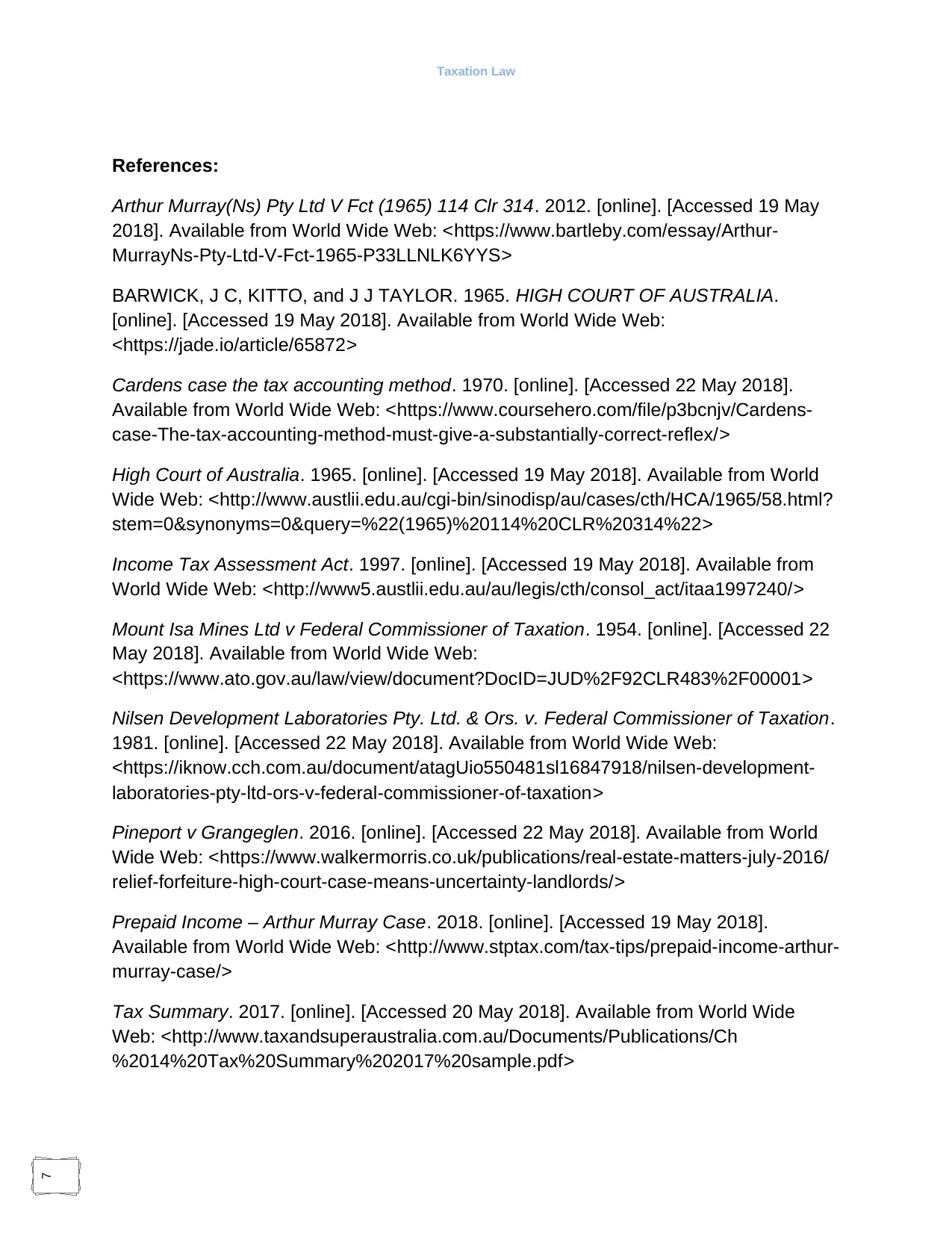
7
Taxation Law
References:
Arthur Murray(Ns) Pty Ltd V Fct (1965) 114 Clr 314. 2012. [online]. [Accessed 19 May
2018]. Available from World Wide Web: <https://www.bartleby.com/essay/Arthur-
MurrayNs-Pty-Ltd-V-Fct-1965-P33LLNLK6YYS>
BARWICK, J C, KITTO, and J J TAYLOR. 1965. HIGH COURT OF AUSTRALIA.
[online]. [Accessed 19 May 2018]. Available from World Wide Web:
<https://jade.io/article/65872>
Cardens case the tax accounting method. 1970. [online]. [Accessed 22 May 2018].
Available from World Wide Web: <https://www.coursehero.com/file/p3bcnjv/Cardens-
case-The-tax-accounting-method-must-give-a-substantially-correct-reflex/>
High Court of Australia. 1965. [online]. [Accessed 19 May 2018]. Available from World
Wide Web: <http://www.austlii.edu.au/cgi-bin/sinodisp/au/cases/cth/HCA/1965/58.html?
stem=0&synonyms=0&query=%22(1965)%20114%20CLR%20314%22>
Income Tax Assessment Act. 1997. [online]. [Accessed 19 May 2018]. Available from
World Wide Web: <http://www5.austlii.edu.au/au/legis/cth/consol_act/itaa1997240/>
Mount Isa Mines Ltd v Federal Commissioner of Taxation. 1954. [online]. [Accessed 22
May 2018]. Available from World Wide Web:
<https://www.ato.gov.au/law/view/document?DocID=JUD%2F92CLR483%2F00001>
Nilsen Development Laboratories Pty. Ltd. & Ors. v. Federal Commissioner of Taxation.
1981. [online]. [Accessed 22 May 2018]. Available from World Wide Web:
<https://iknow.cch.com.au/document/atagUio550481sl16847918/nilsen-development-
laboratories-pty-ltd-ors-v-federal-commissioner-of-taxation>
Pineport v Grangeglen. 2016. [online]. [Accessed 22 May 2018]. Available from World
Wide Web: <https://www.walkermorris.co.uk/publications/real-estate-matters-july-2016/
relief-forfeiture-high-court-case-means-uncertainty-landlords/>
Prepaid Income – Arthur Murray Case. 2018. [online]. [Accessed 19 May 2018].
Available from World Wide Web: <http://www.stptax.com/tax-tips/prepaid-income-arthur-
murray-case/>
Tax Summary. 2017. [online]. [Accessed 20 May 2018]. Available from World Wide
Web: <http://www.taxandsuperaustralia.com.au/Documents/Publications/Ch
%2014%20Tax%20Summary%202017%20sample.pdf>
Taxation Law
References:
Arthur Murray(Ns) Pty Ltd V Fct (1965) 114 Clr 314. 2012. [online]. [Accessed 19 May
2018]. Available from World Wide Web: <https://www.bartleby.com/essay/Arthur-
MurrayNs-Pty-Ltd-V-Fct-1965-P33LLNLK6YYS>
BARWICK, J C, KITTO, and J J TAYLOR. 1965. HIGH COURT OF AUSTRALIA.
[online]. [Accessed 19 May 2018]. Available from World Wide Web:
<https://jade.io/article/65872>
Cardens case the tax accounting method. 1970. [online]. [Accessed 22 May 2018].
Available from World Wide Web: <https://www.coursehero.com/file/p3bcnjv/Cardens-
case-The-tax-accounting-method-must-give-a-substantially-correct-reflex/>
High Court of Australia. 1965. [online]. [Accessed 19 May 2018]. Available from World
Wide Web: <http://www.austlii.edu.au/cgi-bin/sinodisp/au/cases/cth/HCA/1965/58.html?
stem=0&synonyms=0&query=%22(1965)%20114%20CLR%20314%22>
Income Tax Assessment Act. 1997. [online]. [Accessed 19 May 2018]. Available from
World Wide Web: <http://www5.austlii.edu.au/au/legis/cth/consol_act/itaa1997240/>
Mount Isa Mines Ltd v Federal Commissioner of Taxation. 1954. [online]. [Accessed 22
May 2018]. Available from World Wide Web:
<https://www.ato.gov.au/law/view/document?DocID=JUD%2F92CLR483%2F00001>
Nilsen Development Laboratories Pty. Ltd. & Ors. v. Federal Commissioner of Taxation.
1981. [online]. [Accessed 22 May 2018]. Available from World Wide Web:
<https://iknow.cch.com.au/document/atagUio550481sl16847918/nilsen-development-
laboratories-pty-ltd-ors-v-federal-commissioner-of-taxation>
Pineport v Grangeglen. 2016. [online]. [Accessed 22 May 2018]. Available from World
Wide Web: <https://www.walkermorris.co.uk/publications/real-estate-matters-july-2016/
relief-forfeiture-high-court-case-means-uncertainty-landlords/>
Prepaid Income – Arthur Murray Case. 2018. [online]. [Accessed 19 May 2018].
Available from World Wide Web: <http://www.stptax.com/tax-tips/prepaid-income-arthur-
murray-case/>
Tax Summary. 2017. [online]. [Accessed 20 May 2018]. Available from World Wide
Web: <http://www.taxandsuperaustralia.com.au/Documents/Publications/Ch
%2014%20Tax%20Summary%202017%20sample.pdf>
⊘ This is a preview!⊘
Do you want full access?
Subscribe today to unlock all pages.

Trusted by 1+ million students worldwide
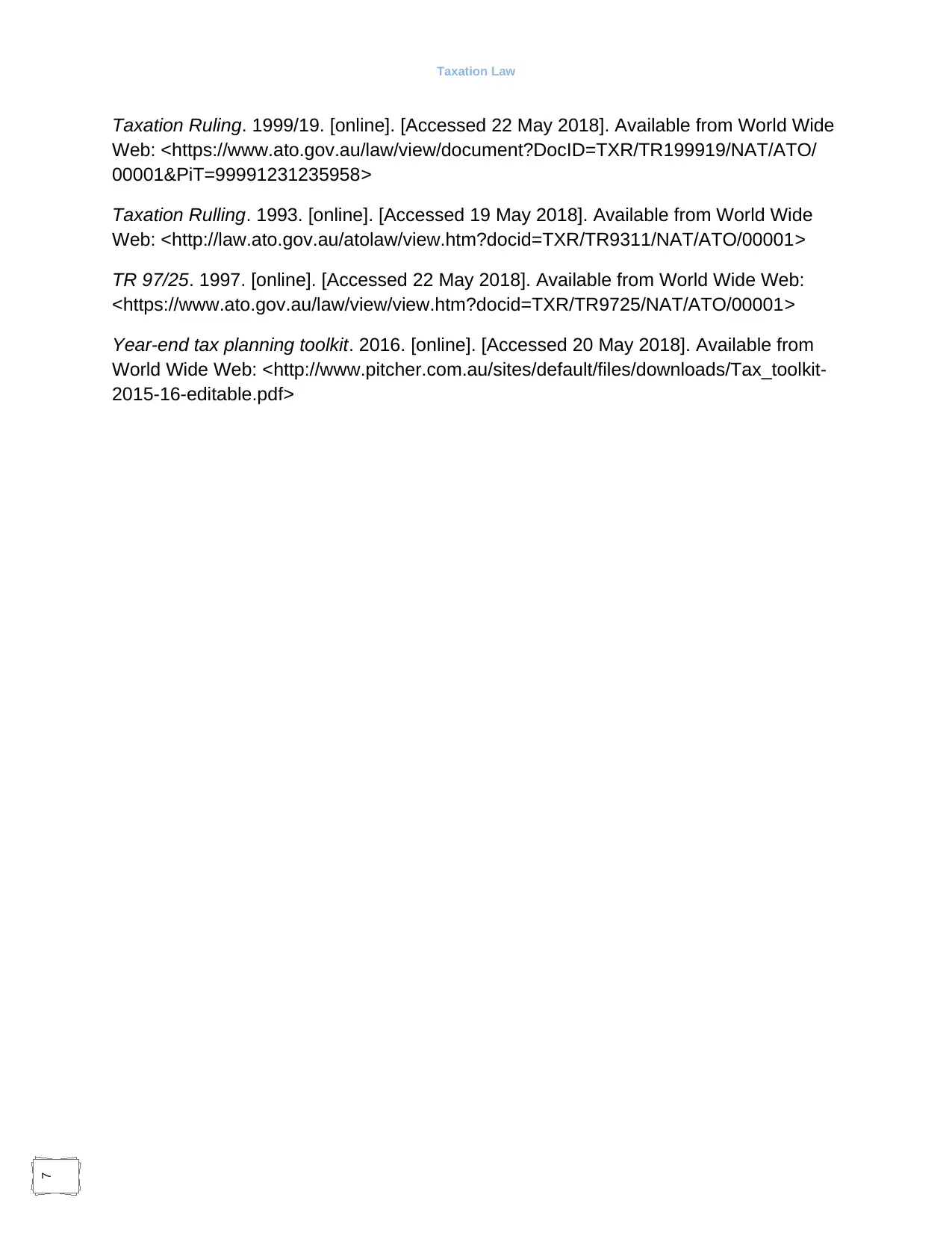
7
Taxation Law
Taxation Ruling. 1999/19. [online]. [Accessed 22 May 2018]. Available from World Wide
Web: <https://www.ato.gov.au/law/view/document?DocID=TXR/TR199919/NAT/ATO/
00001&PiT=99991231235958>
Taxation Rulling. 1993. [online]. [Accessed 19 May 2018]. Available from World Wide
Web: <http://law.ato.gov.au/atolaw/view.htm?docid=TXR/TR9311/NAT/ATO/00001>
TR 97/25. 1997. [online]. [Accessed 22 May 2018]. Available from World Wide Web:
<https://www.ato.gov.au/law/view/view.htm?docid=TXR/TR9725/NAT/ATO/00001>
Year-end tax planning toolkit. 2016. [online]. [Accessed 20 May 2018]. Available from
World Wide Web: <http://www.pitcher.com.au/sites/default/files/downloads/Tax_toolkit-
2015-16-editable.pdf>
Taxation Law
Taxation Ruling. 1999/19. [online]. [Accessed 22 May 2018]. Available from World Wide
Web: <https://www.ato.gov.au/law/view/document?DocID=TXR/TR199919/NAT/ATO/
00001&PiT=99991231235958>
Taxation Rulling. 1993. [online]. [Accessed 19 May 2018]. Available from World Wide
Web: <http://law.ato.gov.au/atolaw/view.htm?docid=TXR/TR9311/NAT/ATO/00001>
TR 97/25. 1997. [online]. [Accessed 22 May 2018]. Available from World Wide Web:
<https://www.ato.gov.au/law/view/view.htm?docid=TXR/TR9725/NAT/ATO/00001>
Year-end tax planning toolkit. 2016. [online]. [Accessed 20 May 2018]. Available from
World Wide Web: <http://www.pitcher.com.au/sites/default/files/downloads/Tax_toolkit-
2015-16-editable.pdf>
1 out of 10
Related Documents
Your All-in-One AI-Powered Toolkit for Academic Success.
+13062052269
info@desklib.com
Available 24*7 on WhatsApp / Email
![[object Object]](/_next/static/media/star-bottom.7253800d.svg)
Unlock your academic potential
Copyright © 2020–2025 A2Z Services. All Rights Reserved. Developed and managed by ZUCOL.




